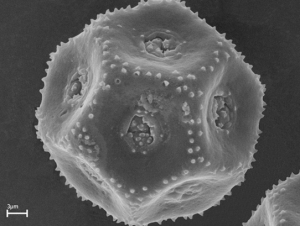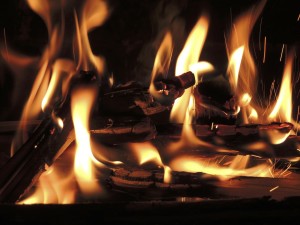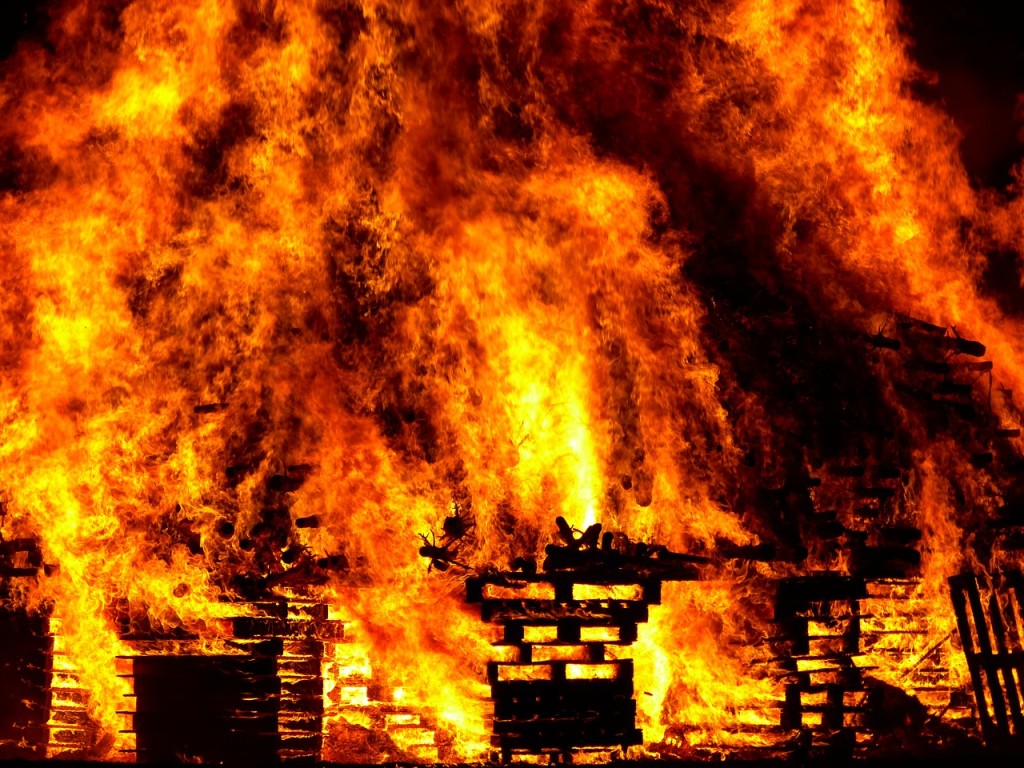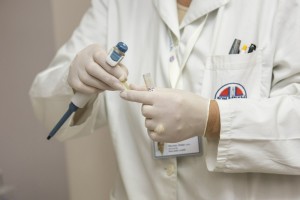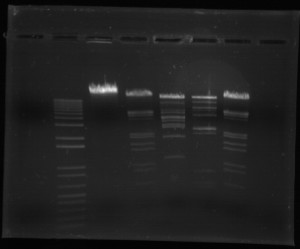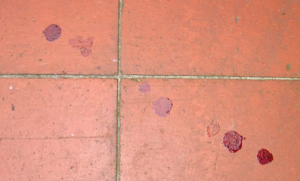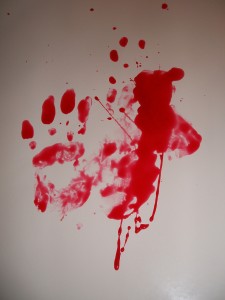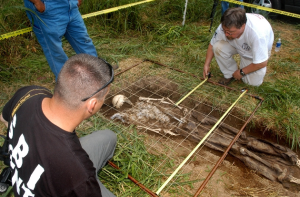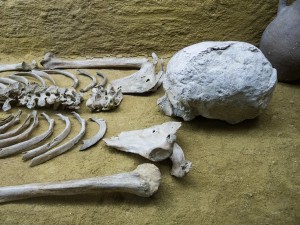
Firearm investigation is a specialty of forensic science focusing on the examination of firearms and related subjects. Closely linked to this is ballistics, which relates to the flight path of projectiles, often associated with forensic science during the investigation of firearms. This area of study examines the path of a bullet from when it leaves the firearm up until it strikes the target. During investigations in which the use of firearms is suspected, a number of artefacts may be collected for examination, including firearms, cartridge cases, bullets, live ammunition, trace materials, and any material damaged by a projectile.
The study of firearms and firearm ballistics is often divided in internal, external and terminal ballistics. Internal ballistics refers to the processes inside the firearm, the minute space of time between the shooter pulling the trigger and the bullet exiting the muzzle of the gun. Following this, external ballistics deals with the bullet’s flight between leaving the firearm and striking a target. Finally, terminal ballistics, also known as impact ballistics, refers to the study of the projectile striking a target.
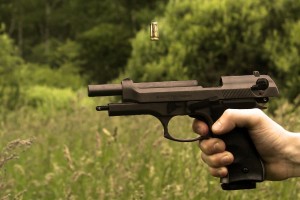
Firearm Mechanism
Although there is a wide range of types of firearm, the basic theory behind how a projectile is fired is fairly generic – the weapon aims to convert chemical energy into kinetic energy in order to expel a projectile from the firearm.
A round is first loaded and locked into the breach. This round consists of an outer cartridge case, a bullet, some form of propellant, and a percussion cap. The firing pin is generally mechanically restrained and, when the firearm is cocked, the firing pin spring is compressed. As the trigger is pulled, the hammer-mounted firing pin is forced forward to strike through a small hole in the breech face, hitting the primer cup. This contains a mixture of sensitive chemicals which rapidly burn, producing sufficient hot gases to ignite the propellant. As the gunpowder is ignited an expansion of gas occurs which, confined in a small space, eventually forces the bullet down the barrel of the firearm. Following discharge, a number of events regarding the used cartridge case may occur depending on the type of firearm. If the firearm is self-loading, a bolt will move back and pull the cartridge case out of the chamber, leading to it being ejected from the weapon. However in weapons such as revolvers, the cartridge will remain in the firearm until the shooter removes it.
The manner in which a firearm is loaded after each shot will vary depending on the type of weapon. Some firearms are bolt action, meaning a bolt ejects the spent cartridge and, when pushing forward, picks up a new cartridge and places it in the chamber, cocking the trigger during this process. Manual action firearms require manual reloading by means of a mechanical device such as lever or pump action. In recoil operated or blow back weapons, pressure generated by the ignited propellant drives back the bolt. Gas operated firearms include a gas port and, until the bullet has passed this point in the barrel, the bolt is locked. An amount of gas leaks into this port and unlocks the bolt, allowing it to move backwards. This ejects the spent cartridge case and loads another. Finally, in a revolving cylinder weapon, pressure on the trigger causes a cylinder containing the cartridges to rotate, positioning a new cartridge so that it may be fired.
Shotguns are available as either single-barrel of double-barrel. Single-barrel weapons can be further classified as single-shot, bolt-action, pump-action, lever-action or self-loading. Double-barrel shotguns encountered may contain a hinge at the barrel, allowing the shooter to open the weapon to reload cartridges. Both of these types of weapon are subject to having their barrel decreased by criminals, producing the “sawn-off” shotgun. The end of many shotgun barrels is designed to incorporate a feature known as the choke, which is a decrease in barrel diameter. This aims to focus the shot of pellets to ensure that they do not spread too much when fired. It is likely that different shotguns will express a difference degree of choke.
The ammunition of shotguns can differ quite considerably from one another. Modern cartridges consist of a metal base containing the primer and either plastic or paper sides with wads between the shot and propellant. Examination of wads, which leave the muzzle along with the shot fired, may indicate both the bore of the shotgun and even the manufacturer. Certain wads, namely those composed of plastic, may hold indentations which indicate the size of the pellet fired from the weapon.
Rifles may be single-shot, lever-action, pump-action, bolt-action or self-loading.
The mechanism of an air weapon is quite different. A piston is forced down a cylinder, often by a compressed spring. This creates a burst of high-pressure air which forces the projectile down the barrel and out of the weapon. Following each shot, the user manually compresses the spring in order to fire another shot. This action compresses the spring again, which is held along with the piston until the trigger is pulled to discharge the firearm. There are other forms of air weapon, such as pneumatic air guns, which do not pressurise the air at discharge but instead use pre-pressurised air.
Bullet Flight
Tracing the flight path of a bullet can provide important details during a forensic investigation, namely from what direction the projectile was fired. This is often vital in reconstructing the series of events throughout an incident. Establishing the path of a bullet may not be straightforward, as numerous factors must be taken into consideration. Air resistance and gravity affect the bullet’s flight path, causing it to project in a downward arc rather than a straight line. Environmental conditions such as strong winds could additionally slightly alter a bullet’s flight. How a bullet’s flight will be affected will depend on the initial velocity of a bullet, as those with a higher velocity will be less influenced, as well as the shape of the bullet. Numerous factors can result in abnormal bullet flight characteristics.
Tumbling is a phenomenon relating to flight imbalance, caused when a bullet is subjected to defective rifling or has been damaged. Another problem is ‘yaw’, an effect referring to a bullet’s deviation from a linear path. This can be caused by defective rifling, poor loading or a badly cast bullet. The choice and loading of bullet can also cause problems. If the user of the firearm loads the weapon with a bullet of incorrect calibre, the bullet may not achieve a spin rate that will ensure stability, resulting in excessive bore friction which ultimately leads to a low muzzle velocity. Incorrect bullet choice can also lead to an excessive bore velocity, causing the bullet to slide over bullet rifling and so resulting in a low spin rate.
Types of Firearm
In the UK, the Firearms Act 1968 describes a firearm as “a lethal barrelled weapon of any description, from which any shot, bullet or other missile can be discharged”. It includes 4 main classes of controlled weapons: firearms, shotguns, prohibited weapons and air weapons.
S1 – Firearms
This section covers a range of guns, including bolt action and straight pull rifles.
S2 – Shotguns
Shotguns are classed as smooth bore guns with a barrel at least 24 inches in length with a maximum diameter of 2 inches. It has no magazine or a non-detachable magazine which cannot hold more than two cartridges, and it is not a revolver gun. Anything other than this will be classed as an S5 weapon.
S5 – Prohibited Weapons
This section includes any firearm disguised as another object, rockets or ammunition not previously categorised, military ammunition and weapons, and machine guns to name a few. In 1997, an amendment was made to this act adding expanding ammunition, such as hollow point bullets, to S5.
Air Weapons
These spring, pre-charged pneumatic or carbon dioxide weapons are also controlled by this act. They use high-pressure air, often pressurised by a piston forced by a compressed spring, to push the projectile down and out of the barrel of the firearm.
All of the above categories can be further divided into a wide range of weapons, some of which are detailed below.
Semi-Automatic: Once cocked, this weapon will load itself from the magazine, which can hold dozens of. This allows for fast reload and so a high rate of fire.
Revolver: A revolver is a type of pistol which holds the ammo in a rotating drum, holding between 5 and 7 shots. After each shot, the cylinder is rotated and the next shot is aligned with the barrel. Its relatively short barrel means it is fairly inaccurate and it has a slow reload time.
Rifle: Essentially a long rifled barrel firearm primarily designed for relatively long range use in warfare or hunting. Rifles are available as single shot, self-loading, manual action, bolt action or automatic, though most commonly encountered are self-loading. Another form of rifle is the shorter barrelled assault rifle, commonly used in the military.
Submachine Gun: A fast-loading weapon with a high rate of fire, available as single shot or fully automatic. The inaccurate SMG is a magazine-fed weapon which can hold up to around 100 rounds, designed for continuous fire.
Machine Gun: This has a very high rate of fire with a fast reload time and great power. They are generally only used by the military.
Shotgun: A smooth bored, powerful weapon with a short range and low accuracy. It can fire a number of types of ammunition, including solid slugs or pellets. Although there are numerous types of shotgun, single or double barrel are most commonly encountered. Single barrel shotguns can be single shot, self-loading or manual action. The barrel is traditionally long but is sometimes shortened to produce a ‘sawn-off’ shotgun to aid concealment. The end of the barrel may be slightly tapered in order to reduce the shot from spreading as it leaves the muzzle of the firearm. This effect is known as the choke.

Bullets
One of the primary methods of categorising bullets is based on their calibre. Calibre refers to the diameter of the bullet, which can be expressed in various terms, including millimetres (metric system), inches (imperial system) or 100ths of an inch (American system). For example, a 9mm bullet may also be referred to as a 0.35 inch bullet or .35 calibre. However it must be taken into consideration that the calibre of a bullet does not necessarily prove the calibre of the weapon used to fire it, as on occasion a cartridge too large or two small may be used.
Bullets are generally composed of metal, although substances such as plastic or rubber may be used. The core of a bullet most commonly consists of lead, as it is very dense and yet easily moulded so as to produce a gas-tight seal in the barrel upon being fired. However this also means that it will easily become deformed on impact, therefore it is commonly combined with other materials, often copper, tin or antimony, to ensure it will withstand pressure.
The use of a lead bullet can also lead to a problem known as “leading”, in which friction between the bullet and barrel results in the transfer of metal to the barrel, ultimately causing less accuracy. Therefore copper is frequently used to jacket the bullet to reduce the lead being deformed and improve the effects of rifling. For this reason lead is often combined with other metals such as copper, tin or antimony to strengthen the projectile. Lubrication may also be applied to the surface of the bullet. However these techniques can only reduce the problem of leading, therefore bullets are commonly enclosed in some form of ‘jacket’.
A full metal jacket involves a metal such as copper being used to cover the entire outer surface of the bullet. Fully jacketed bullets often display high accuracy and penetration. Some bullets are semi-jacketed, with a partial copper covering with a hollow or blunt lead tip. In this case the nose of the bullet is exposed and this type of bullet can severely deform on impact into a ‘mushroom shape’, producing greater damage. Bullets may also be unjacketed, though these projectiles have a low muzzle velocity and do not penetrate deeply.
Shotgun cartridges differ significantly from bullets. They are generally loaded with pellets or shot, which are small, round metallic balls. Shotguns can also fire single, larger projectiles as well. The shotgun cartridge may also contain a number of wads, which are designed to provide a form of gas seal in the bore. These wads may be found at the scene or even embedded in the target, and can be chemically analysed to provide details of the propellant and primer.
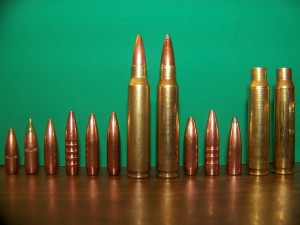
Cartridges
The examination of cartridges, precisely-fitting metal cases containing the bullet, propellant and primer, can provide vital information to an investigation. The composition of most cartridge cases is brass, an alloy of zinc and copper, ideal due to its low density, though other metals may be used. Similar to calibre, chambering refers to the shape and size of a cartridge. The primer, held in the primer/percussion cap at the base of the cartridge case, consists of a small amount of explosive, a fuel and an oxidiser. Modern primers generally consist of lead styphnate, barium nitrate and antimony sulphide, though the substances used may vary. The propellant, often referred to as “gunpowder”, is an explosive mixture designed to ignite and produce enough hot gas to force a projectile from the firearm.
In some instances cartridge cases may be found at the scene of a shooting, though this often depends on the type of gun used. As previously stated, self-loading handguns will eject the cases from the weapon, whereas revolvers retain the cartridges until the shooter manually removes them. However the absence of cartridge cases is not an accurate sign of the type of firearm used, as the perpetrator may have picked up the cases from the scene before leaving.
Initially, any cartridge cases retrieved from the scene should be accurately measured in all dimensions to aid future comparison. The examination of any cartridge cases found can provide clues as to the firearm used during the shooting. For example, cartridges designed for use in a revolver have projecting base rims, whereas those designed for self-loading firearms do not.
Cartridge cases also bear more distinguishing features that can be used to identify them. The headstamp is an indentation produced at the base of many cartridges during the manufacturing process. These markings can then be used to trace a cartridge back to the manufacturer and determine the make and type of the ammunition. Various sources are available to help identify headstamps. When the firing pin strikes the cartridge case, a characteristic indentation is caused that can be used to link cartridges to specific firearms, similar to the comparison of rifling marks (discussed below). Other markings that should be looked for include ejector, extractor and breech face marks. Firearms often have different firing pin, extractor and ejector designs, therefore the examination and comparison of marks produced by these implements can aid in establishing the firearm used. It should be noted that it is possible for cartridge cases to be reloaded with a new bullet and fresh propellant and primer and reused, in which case the cartridge may bear numerous additional markings. Furthermore, cartridge cases recovered from the shooting scene should be examined for fingerprints and similar forensic evidence.
Rifling
During the manufacturing process of firearm barrels, a series of spiralling lands and grooves is produced along the inside of the barrel, known as rifling. Land refers to the raised portion of these spiralling indentations, whereas the grooves are the lower portions between these lands. Rifling, which can be one of numerous types, will be cut with either a left or right hand twist, determining whether the bullet will spin clockwise or anticlockwise. As the bullet passes through the barrel, these markings cause the projectile to spin, increasing stability and accuracy whilst leaving characteristic marks on the bullet itself. The grooves present on the surfaces of bullets are unique to the barrel that caused them, making rifling patterns ideal in matching bullets to specific firearms. Bullets are often viewed side by side using a comparison microscope, allowing rifling patterns to be contrasted and any similarities noted. The type and number of spiral grooves, their measurements, and whether they rotate clockwise or anticlockwise can help narrow down the search for the weapon used. Measuring the calibre of a bullet and the angle of grooves can allow for the calculation of twists per metre and thus provide further details of the rifling of a particular firearm.
Serial Number Restoration
During the manufacturing process, legally produced firearms are stamped with a uniquely identifying serial number, usually on the barrel or action. These numbers are stamped into the firearm, a process which also impresses the digits below the surface of the metal. Even though criminals may attempt to erase these serial numbers to avoid the weapon being traced, it may be possible to restore these serial numbers to a state in which they are legible. Serial numbers are often erased by filing or grinding, which will not necessarily remove the digits below the surface. Alternatively the perpetrator may attempt to change the serial number. Various techniques and reagents have been used to successfully restore these original numbers.
Fry’s Reagent is a substance composed of hydrochloric acid, copper(II) chloride, ethanol and water, commonly used on iron and steel. Other reagents are available for use on other types of metal. Initially the metal is polished to smooth the surface, a process which in itself may partially restore some of the digits. Following this, the etching reagent is then applied using a cotton swab, removing scratches and markings covering the numbers. This process can be repeated until the entire serial number is restored. However chemical etching methods can be very time consuming and are obviously damaging to the evidence.
An alternative method of restoring serial numbers on iron or steel is the Magnaflux method. As in the chemical etching method, the surface to be treated is first smoothed. A magnet is then attached behind the area and a mixture of iron filings mixed in a light oil is added to the surface. These minute metallic pieces will hopefully arrange themselves to visualise each digit. This technique is particularly beneficial due to its non-destructive nature, however it is not effective on all types of metal.
Similar to serial numbers are proof marks, markings imprinted on a firearm specific to the manufacturer or testing facility. These unique imprints are applied to a weapon before it is released and after any significant repair work is conducted on the firearm.
Gunshot Residues
When a firearm is discharged, a cloud of gases and fine particles is released composed of gunshot residues (GSR), sometimes referred to as firearms discharge particles (FDRs) or cartridge discharge residues (CDRs). The mixture will often contain both organic and inorganic particulates, the organic matter consisting of unburned and partially combusted propellant and inorganic matter produced by hot gases acting on the bullet. When released, these fine particles will settle on any nearby surfaces and are easily carried away from the scene. The presence of such residues can provide strong links between suspects or objects and the scene of a shooting, therefore various methods of detecting gunshot and other residues have been developed.
Gunshot residues are initially collected using swabbing, washing an item with dilute acid, film lifts or adhesive tape. Once collected, these resides can be analysed and compared both physically and chemically. Initially colour tests such as the paraffin test were previously used, though this lacked sensitivity and specificity so is no longer utilised. Further methods such as the Greiss test were developed to detect gunshot residues, however it was soon established that this technique was not sensitive enough and positive results could be caused by any nitrites.
Scanning electron microscopy with energy dispersive X-ray spectroscopy has been successfully utilised in visualising and detecting minute particles associated with firearms. This technique allows for the morphology of the particles to be observed and their chemical compositions established.
Neutron activation analysis (NAA) is a technique primarily used for determining concentrations of elements and has been used in the analysis of residues from firearms. However the use of this technique is very expensive and requires access to a nuclear reactor which is not readily available to all organisations. Flameless atomic absorption spectroscopy (FAAS) largely replaced the use of NAA due to it having various advantages and costing a more reasonable price.
Distance Determination
When a weapon is discharged, various gunshot residues will be ejected onto any nearby surfaces. The examination of gunshot residue has been utilised in establishing the distance from which a firearm was discharged. For example, the closer a firearm is to the target, in theory the more concentrated the gunshot residue pattern will be, whereas shots fired from a greater distance will produce a more widespread pattern. Research has also been conducted into the study of the chemical composition of gunshot residues in determining firing distance. Analytical techniques have been used to analyse the elemental composition of gunshot residue produced during the discharge of a firearm at varying distances. Attempts have been made to produce a mathematical model by which firing distance can be determined based on the elements and their relative amounts present in the residue. However it should be taken into consideration that the use of gunshot residues in establishing firing distance can only give an estimated distance at best.
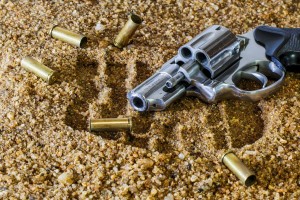
Shooting Scene Investigation
A number of points will be aimed to be established in regards to the scene of a shooting, namely the number of shots fired, the direction from which the projectiles originated, and the type of ammunition and firearm used. A thorough examination of a shooting scene is often vital to the accurate reconstruction of events. The exact location of spent bullets and cartridge cases and even the firearm itself should be thoroughly documented before the evidence is collected. Similarly, the location of any bullet damage should also be photographed and, if possible, collected. A post-mortem examination of victims may be required to retrieve bullets and fragments.
Suspects of shootings incidents may claim that the firearm was unintentionally discharged, either accidentally by the individual or through malfunction of the weapon. Various tests can be conducted on the suspect firearm to help establish the details of the shooting. Trigger pressure relates to the force required to pull a trigger and fire a weapon. In some cases firearms with light trigger pulls may result in accidental discharge, so by calculating the trigger pressure it may be possible to determine the likelihood that the trigger was accidentally pulled. Some firearms allow the user to select either normal trigger pull or light trigger pull (hair trigger); therefore it is also important to discover whether the firearm has this feature and which setting was selected. Firearms are often fitted with numerous safety mechanisms. The examination of the firearm should include the investigation of these mechanisms to conclude whether any of the safety features were malfunctioning. An investigation known as a jarring test may also be performed, in which the firearm is subjected to a series of impacts involving various surfaces and distances to determine whether the action could have resulted in the firearm being discharged.
Projectile-Surface Interactions
The effects caused when a bullet strikes the target will vary depending on numerous factors, particularly the material of the target.
Wood – When a bullet penetrates a wooden object, the entry hole will generally be neat but the exit hole will often be jagged and splintered. The type of wood will cause variations in the bullet hole, as hard wood does not usually display as much splintering.
Glass – The effects of a bullet on glass will vary significantly depending on the type of glass. Some forms of glass will simply shatter, whereas on other occasions the projectile will pass straight through it, leaving bullet holes. Laminated glass, such as that used in car windshields, is manufactured with a layer of plastic sandwiched in the middle. Therefore, if penetrated by a bullet, although the glass will break, it will often be held together in a sheet. Tempered glass will break into many small, dull pieces. Some forms of glass, namely used in banks or by the military, are bullet-resistant and will not generally shatter when fired at.
The velocity of the projectile will also produce varying effects. High velocity rounds often result in small, tidy holes with little glass fracturing, whereas low velocity bullets will cause more damage to the glass. Studying the radiating cracks formed around the bullet hole can also help determine the order of bullet impacts. If the radiating line meets a pre-existing fracture, it will stop, indicating it was produced after the pre-existing crack.
Metal – Depending on the type of metal the surface is composed off, the bullet may ricochet off the target, dent or become lodged in the material, or produce a bullet hole. If the bullet does penetrate the metal, the entry hole will generally be fairly neat. Any exit holes will project outward slightly in a funnel-like manner.
Fabric – Bullets tend to pass straight through fabrics, producing a bullet wipe ring and, if close enough, depositing gunshot residues around the bullet hole. Different types of fibre will be affected differently by the interaction with a bullet. Natural fabrics tend to tear, resulting in a frayed bullet hole edge, whereas synthetic fibres may melt slightly.
Firearm Examination
Before the examination of any firearm can be conducted, it must first be established that the weapon is not loaded and it is safe to handle. This check should be carried out by an appropriately trained individual. During the initial examination of a firearm, a number of details should be noted. This includes the state of the weapon when received, its type, the make and model, the serial number and any other unique engravings and anything else that the investigator deems important. It is vital to document whether the weapon was locked or cocked, the position of the safety catch, and how many cartridges remain in the firearm’s cylinder or magazine.
In some instances it may be necessary to load and even test-fire a weapon into water or a gelatine block to obtain test bullets and cartridge cases, often for purposes of comparison with items of evidence. Again, this should only be carried out by a competent person in a safe environment, and at times it may be necessary to use a remote firing device rather than using the firearm by hand. When dealing with a self-loading weapon that ejects spent cartridge cases, the direction and distance travelled by ejected cartridges should be documented. Test-firing a suspect weapon should only occur once other forensic tests have been completed (fingerprinting, swabbing, etc). It may also be necessary to measure the trigger pressure of the weapon. Following this, the weapon should once again be checked to make sure it is not loaded before being returned to storage.
One of the primary focuses of the investigation of a firearm is often to establish whether or not the weapon was responsible for firing the shots in question. Various pieces of evidence recovered from the shooting scene can be used to establish this, including spent ammunition, cartridge cases, gunshot residues and the characteristics of wounds or other bullet damage. This evidence can help narrow down the search for the weapon used. For example, if scattered shotgun pellets are found at a scene, it is likely that investigators are looking for some form of shotgun. However it must be taken into account that weapons can be modified to fire a variety of ammunition, so the investigator should always keep an open mind.
Databases
Databases have been produced to store images of bullets and cartridge cases, allowing comparisons and matches to be made. In the UK, the Forensic Science Service and the Association of Chief Police Officers set up the National Firearms Forensic Intelligence Database, a system allowing information on weapons and firearms to be stored and analysed. This was later replaced by the National Ballistics Intelligence Service database. The FBI sponsors the database Drugfire, an automation nation system combining images input by users with a reference library.
Firearms Act 1968
Jackson, A. R. W, Jackson, J. M., 2011. Forensic Science. Essex: Pearson Education Limited.
White, P. C., 2004. Crime Scene to Court: The Essentials of Forensic Science. Cambridge: The Royal Society of Chemistry.
1 – Almeida, A A. Magaljaes, T. Santos, A. Sousa, A V. Vieira, D N. Firing Distance Estimation through the Analysis of the Gunshot Residue Deposit Pattern Around the Bullet Entrance Hole by Inductively Coupled Plasma Mass Spectrometry – An Experimental Study. American Journal of Forensic Medicine and Pathology. 2007, 28(1), 24-30.
 Forensic palynology relates to the application of the study of pollen and spores to legal matters, often used to establish links between objects, people and places based on the analysis and identification of pollen.
Forensic palynology relates to the application of the study of pollen and spores to legal matters, often used to establish links between objects, people and places based on the analysis and identification of pollen.

